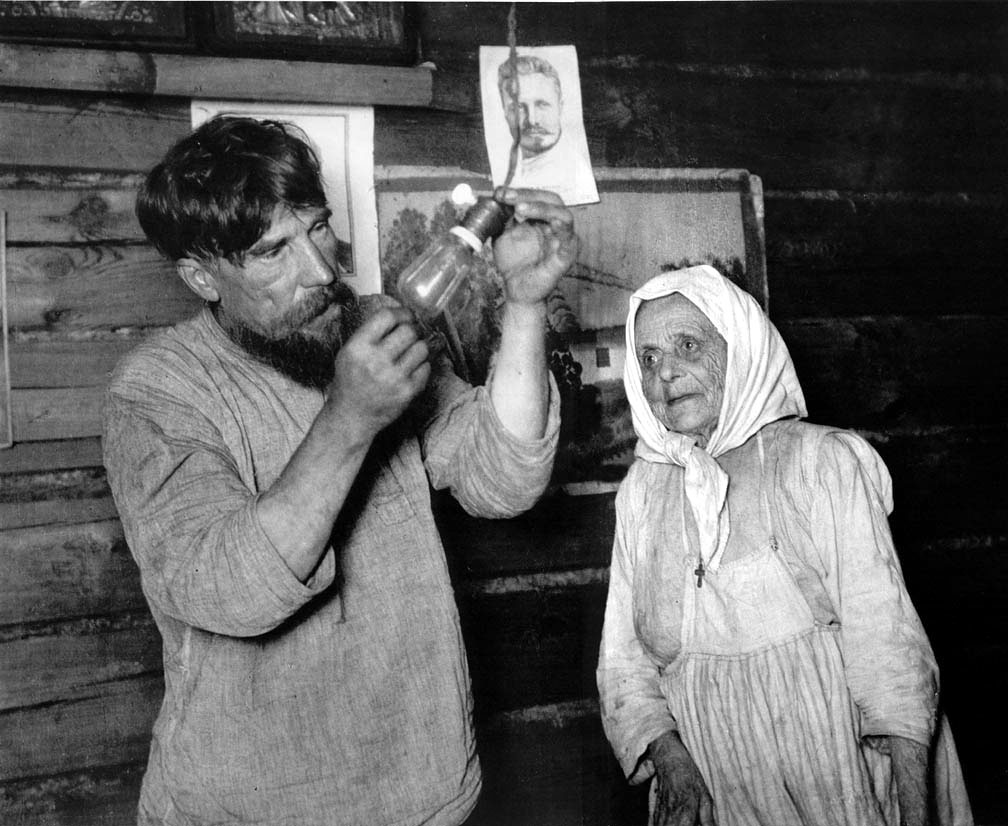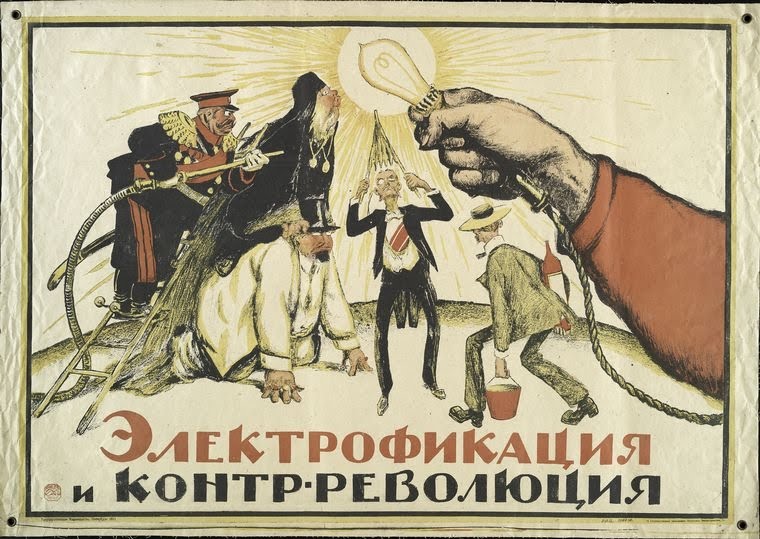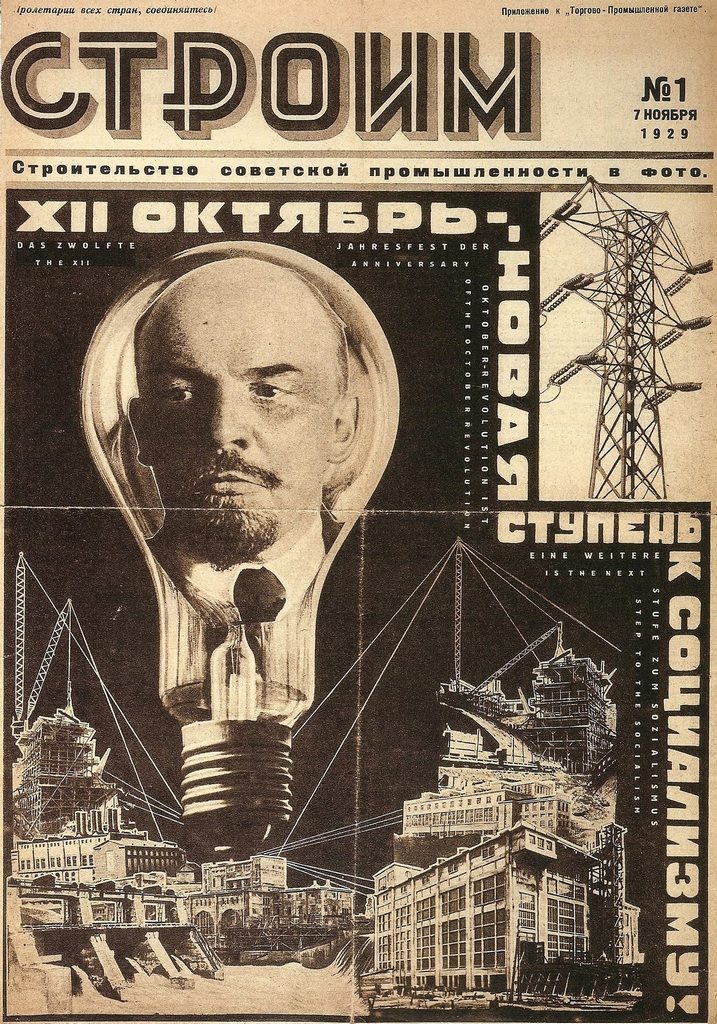By Eric Laursen (W&M Contributor)
In Arkady Shaikhet’s photograph “Lenin’s Lamp” (1925) two peasants examine a light bulb hanging from a cord that appears to be strung through the portrait of Mikhail Frunze, Bolshevik and son of a peasant. Electricity seems to be directed from Frunze’s mind and into the hands of the unenlightened peasant, whose traditional haircut and clothing contrast sharply with Frunze’s and point to the intended modernizing influence of the electrification campaign. In the early Soviet period, showing the light-bulb–nicknamed “Lenin’s lamp”–to the peasants became a demonstration of technology that Lenin claimed would “show the population, especially the peasants, that we have [. . .] broad plans which aren’t taken from fantasies, but supported by technology grounded in science.” The image showed up on posters, lacquered boxes, and even in a children’s cartoon. The light-bulb may seem a strange choice of evidence to prove that communism is not “fantasy,” but as seen in Shaikhet’s often-reproduced photograph, the light-bulb is endowed in Soviet propaganda with the significance of a religious artifact that merely needs to be touched or seen in order to work wonders. The peasant is presented in Bolshevik propaganda about electrification as a scapegoat for everything regressive in post-revolutionary Russia; Lenin writes: “[Electrification] will enable us to fully and decisively defeat that backwardness, that fragmentation, disintegration, the darkness of the countryside, that is to this point the main cause of all stagnation, all backwardness, all oppression.” Lenin presents electricity as a high-tech adhesive that could mend the “fragmentation, disintegration” of the countryside and meld the dark fragments into one cohesive brightly-lit whole, lighting up the darkness both literal and figurative. The primitive, flickering light of the peasant home and work-place would be replaced by Lenin’s lamps: “Cheap light energy from mighty regional electrical stations spreads around the whole country, goes right up to village huts with their wood-splinter torches and other home-grown means of illumination, overthrowing the coarse backwardness of village life.”
Repeatedly, Bolshevik propaganda argued that electricity would defeat capitalism, religion, hierarchy and exploitation. In the 1923 poster “Electrification and Counter-revolution” an enormous hand holds up one of Lenin’s lamps, and a group of stereotypical counterrevolutionaries representing the evils of the class system try to extinguish its light. To the left of the light bulb a fat capitalist crouches on his hands and knees so that a White general and an Orthodox priest can climb up on his back with a fire hose; to the right a fashionable gentleman fetches a bucket of water; and in the center a foreign diplomat attempts to blow out the light bulb with a small bellows. The tiny figures each wear identifying markers of the exploiting class—clerical garb, gold epaullettes, a top hat, a gentleman’s straw boater, and a monocle. They also wear technological ignorance and backwardness on their well-tailored sleeves. Under the electric light of the proletariat they become comic buffoons, motivated by fear and greed and fighting the progress of technology with the ineffectual weapons of a more primitive age. Embodied in the electrification campaign is the promise that with technological superiority comes moral purity. The proletarian hand, like the right hand of God, gives humanity the light of truth, guiding followers to the bright future and illuminating the technologically ignorant exploiters of humankind, so that they can be seen as cartoon figures, easily defeated by the mighty–electrified–Soviet hand.
As we can see in the cover of the November 7, 1929 issue of We Build, a Soviet journal dedicated to construction photography, after his death in 1924, Lenin’s image became inextricably linked to the lamps that carried his name and that fought the darkness of ignorance. Here Lenin’s head is enclosed in an enormous light bulb, a fusion of human and technology that gives new meaning to the term “Lenin’s lamp.“ Below the disembodied Lenin’s lamp, we see one of the massive hydroelectric dams envisioned by the electrification campaign and the constructions enabled by their power. A power tower is pictured in the upper right-hand corner. Moving diagonally down the page and separating the picture of the construction site from the picture of the electric tower is a series of letters forming steps that spell out: “XII October is a New Step toward Socialism,” in large font in Russian and in smaller letters in German and English–to show the triumph of Soviet construction over the leading industrialized countries of the world. In this tribute to the twelfth anniversary of the October revolution and the first five-year plan, Lenin’s head becomes a source of light for everything contained in the picture; and, by implication, in the journal issue that follows. The power goes both ways. The lines connecting the base of the light-bulb to the tops of cranes and the roofs of factories also charge up the light-bulb and by implication the memory of Lenin, who “lived, lives, and will live” in memorials like this one that help the Soviet people move up the stairway to socialism. According to the circular logic displayed in the image, each year after the revolution takes another “step toward socialism” through the human energy that accomplishes monumental construction feats, and it also produces energy for revolutionary enlightenment that will push the Soviet people up one more step. The cult of Lenin and technology that is powered by the head in the light bulb is an energy loop of propaganda and construction, each of which feeds energy to the other.



